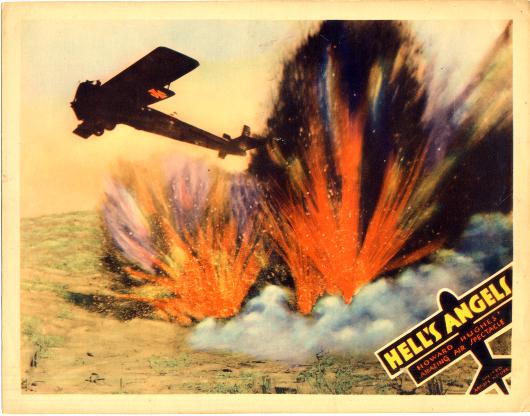Hell’s Angels
went into production in the silent era. While it was being filmed
the craze for sound erupted and producer Howard Hughes reshot most of
it as a talkie. This resulted in a film that cost nearly four
million dollars and took almost three years to complete.
Along the way Hughes lost his first director, Marshall Neilan, and took
the reins himself, bringing in James Whale, fresh from the English
theater, to “stage” the dialogue scenes.
The result is a mess, but also one of the God-damnedest entertainments
ever concocted in Hollywood — an absolutely fascinating folly.

The film is made up of four poorly integrated elements:
1) A creaky melodrama about two brothers involved with the same women
who end up serving together in the Royal Flying Corps in WWI.
2) A showcase for the miraculous cinematic presence of an 18 year-old Jean Harlow.
3) An extended sequence about a Zeppelin raid on London with stunning miniatures and special effects.
4) A twenty-minute episode of ariel combat shot in and from real planes that has to be seen to be believed.
The inadequacy of element 1) is what makes the film a bit of a chore to
sit through, though the other three elements make the effort intensely
rewarding at times.
Harlow doesn’t have much of a role and
doesn’t really act it — but she’s such a natural screen performer that
you simply don’t care. Watching her have her being in front of a
camera is as thrilling as watching the mind-boggling stunts of the
flyers at the end of the film.
The Zeppelin raid seems to belong to another film entirely — it has a
spooky, morbid tone and an expressionistic visual style that hark back
to the great UFA films of the 1920s. It’s extremely beautiful and
haunting but has no organic connection to the film’s narrative.
The twenty-minutes of ariel combat must rank among the highest
achievements in all of cinema. The lead actors in the film appear
in actual planes that are actually flying. Flyers in other planes
act out moments of the airborne drama. A complex ariel battle
unfolds lyrically and logically before our eyes — almost all of it
done for real.
Three flyers were killed during the production — only one of them,
though, during actual shooting, in a stunt gone wrong. The
dangers all the flyers risked is there on the screen at every moment,
however, and the result is truly breathtaking.
It’s sad that these twenty minutes of cinematic bravura don’t provide
the climax to a great film, or even a very good film, but they will
always constitute one of the great legacies of the movies . . . and of
a sort we will probably never see again. Martin Scorsese
recreated the filming of Hell’s Angels in his biopic of Hughes, The Aviator, using CGI. Compared to Hughes’s folly Scorsese’s homage is a big yawn.
